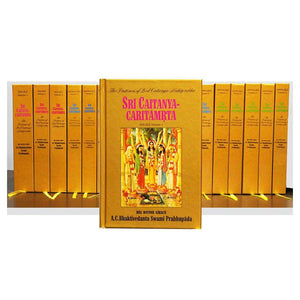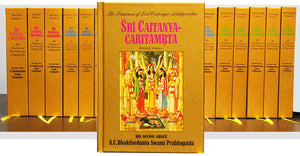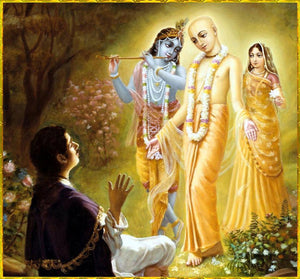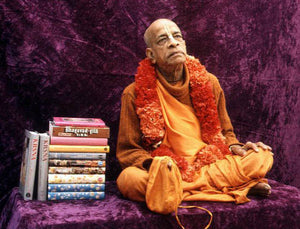NEW PRINTING OF ORIGINAL EDITION
The life and teachings of Sri Caitanya Mahaprabhu in 17 volumes featuring the Bengali text with English equivalents, translation and elaborate commentary. Profusely illustrated with hundreds of beautiful paintings and photographs. Original 1974 edition. Author: A.C. Bhaktivedanta Swami Prabhupada.
Format: 17 Volume Set, Hard Cover, A5 (5.8" x 8.3")
Pages: 400 Pages / Volume on averag
The pastimes of Lord Caitanya are divided into three divisions: Adi-lila (the pastimes in the beginning), Madhya-lila (the pastimes in the middle) and Antya-lila (the pastimes at the end).
Adi-lila Volume 1
The Spiritual Masters
Sri Caitanya Mahaprabhu Is the Supreme Personality of Godhead
The External Reasons for Lord Caitanya's Appearance
The Confidential Reasons for Lord Caitanya's Appearance
The Glories of Lord Nityananda Balarama
The Glories of Sri Advaita Acarya.
Adi-lila Volume 2
Lord Caitanya in Five Features
The Author Receives the Orders of Krishna and Guru
The Tree of Devotional Service
The Trunk, Branches and Sub-branches of the Caitanya Tree
The Expansions of Lord Nityananda.
Adi-lila Volume 3
The Expansions of Advaita Acarya and Gadadhara Pandita
The Advent of Lord Sri Caitanya Mahaprabhu
Lord Caitanya's Childhood Pastimes
The Lord's Pauganda-lila
The Pastimes of the Lord in His Childhood and Youth.
Madhya-lila Volume 1
The Later Pastimes of Lord Sri Caitanya Mahaprabhu
The Ecstatic Manifestations of Lord Sri Caitanya Mahaprabhu
Lord Sri Caitanya Mahaprabhu's Stay at the House of Advaita Acarya.
Madhya-lila Volume 2
Sri Madhavendra Puri's Devotional Service
The Activities of Saksi-gopala
The Liberation of Sarvabhauma Bhattacarya.
Madhya-lila Volume 3
The Lord's Tour of South India
Talks Between Sri Caitanya Mahaprabhu and Ramananda Raya
Lord Sri Caitanya Mahaprabhu's Travels to the Holy Places.
Madhya-lila Volume 4
The Lord's Return to Jagannatha Puri
The Beda-kirtana Pastimes of Sri Caitanya Mahaprabhu.
Madhya-lila Volume 5
The Cleansing of the Gundica Temple
The Ecstatic Dancing of the Lord at Ratha-yatra
Performance of the Vrndavana Pastimes.
Madhya-lila Volume 6
The Lord Accepts Prasada at the House of Sarvabhauma Bhattacarya
The Lord's Attempt to Go to Vrndavana.
cbh
Madhya-lila Volume 7
The Lord Travels to Vrndavana
Lord Sri Caitanya Mahaprabhu's Visit to Sri Vrndavana
Lord Sri Caitanya Mahaprabhu Instructs Srila Rupa Gosvami.
Madhya-lila Volume 8
Lord Sri Caitanya Mahaprabhu Instructs Sanatana Gosvami in the Science of the Absolute Truth
The Opulence and Sweetness of Lord Sri Krsna
The Process of Devotional Service.
Madhya-lila Volume 9
Life's Ultimate Goal--Love of Godhead
The Sixty-One Explanations of the Atmarama Verse
How All the Residents of Varanasi Became Vaisnavas.
Antya-lila Volume 1
Srila Rupa Gosvami's Second Meeting With the Lord
The Chastisement of Junior Haridasa
The Glories of Srila Haridasa Thakura.
Antya-lila Volume 2
Sanatana Gosvami Visits the Lord at Jagannatha Puri
How Pradyumna Misra Received Instructions from Ramananda Raya
The Meeting of Sri Caitanya Mahaprabhu and Raghunatha dasa Gosvami.
Antya-lila Volume 3
The Meeting of Sri Caitanya Mahaprabhu and Vallabha Bhatta
Ramacandra Puri Criticizes the Lord
The Deliverance of Gopinatha Pattanayaka
Sri Caitanya Mahaprabhu Accepts Prasada from the Devotees.
Antya-lila Volume 4
The Passing of Haridasa Thakura
The Loving Dealings Between Lord Sri Caitanya Mahaprabhu and Jagadananda Pandita
Pastimes with Jagadananda Pandita and Raghunatha Bhatta Gosvami
Lord Sri Caitanya Mahaprabhu's Feelings of Separation from Krishna
The Transcendental Madness of Lord Sri Caitanya Mahaprabhu.
Antya-lila Volume 5
Lord Sri Caitanya Mahaprabhu Tastes Nectar from the Lips of Lord Sri Krishna
The Bodily Transformations of Lord Sri Caitanya Mahaprabhu
Rescuing the Lord from the Sea
The Inconceivable Behavior of Lord Sri Caitanya Mahaprabhu
The Siksastaka Prayers
Concluding Words.
Introduction
"(Originally delivered as five morning lectures on the Caitanya-caritāmṛta-the authoritative biography of Lord Caitanya Mahāprabhu by Kṛṣṇadāsa Kavirāja Gosvāmī-before the International Society for Krishna Consciousness, New York City, April 10-14, 1967.)
The word caitanya means "living force." As living entities, we can move, but a table cannot because it does not possess living force. Movement and activity may be considered signs or symptoms of the living force. Indeed, it may be said that there can be no activity without the living force. Although the living force is present in the material condition, it is not amṛta, immortal. The words caitanya-caritāmṛta, then, may be translated as "the character of the living force in immortality."
But how is this living force displayed immortally? It is not displayed by man or any other creature in this material universe, for none of us are immortal in these bodies. We possess the living force, we perform activities, and we are immortal by our nature and constitution, but the material condition into which we have been put does not allow our immortality to be displayed. It is stated in the Kaṭha Upaniṣad that eternality and the living force belong both to ourselves and God. Although this is true in that both God and ourselves are immortal, there is a difference. As living entities, we perform many activities, but we have a tendency to fall down into material nature. God has no such tendency. Being all-powerful, He never comes under the control of material nature. Indeed, material nature is but one display of His inconceivable energies.
From the ground we may see only clouds in the sky, but if we fly above the clouds we can see the sun shining. From the sky, skyscrapers and cities seem very tiny; similarly, from God's position this entire material creation is insignificant. The tendency of the conditioned living entity is to come down from the heights, where everything can be seen in perspective. God, however, does not have this tendency. The Supreme Lord is not subject to fall down into illusion (māyā), any more than the sun is subject to fall beneath the clouds. Because the Supreme Lord is not subject to illusion, He is unconditioned; because we, as finite living entities, are prone to fall into illusion, we are called conditioned. Impersonalist philosophers (Māyāvādīs) maintain that both the living entity and God Himself are under the control of māyā when they come into this material world. This may be true of the living entity, but it is not true of God, for in all instances the material energy is working under His direction. Those who think the Supreme Lord is subject to material conditioning are called fools by Kṛṣṇa Himself in the Bhagavad-gītā (9.11):
avajānanti māṁ mūḍhā
mānuṣīṁ tanum āśritam
paraṁ bhāvam ajānanto
mama bhūta-maheśvaram
"Fools deride Me when I descend in the human form. They do not know My transcendental nature as the Supreme Lord of all that be." (Bg. 9.11)
Lord Caitanya Mahāprabhu should not be considered one of us. He is Kṛṣṇa Himself, the supreme living entity, and as such He never comes under the cloud of māyā. Kṛṣṇa, His expansions and even His higher devotees never fall into the clutches of illusion. Lord Caitanya came to earth simply to preach kṛṣṇa-bhakti, love of Kṛṣṇa. In other words, He is Lord Kṛṣṇa Himself teaching the living entities the proper way to approach Kṛṣṇa. He is like a teacher who, seeing a student doing poorly, takes up a pencil and writes, saying, "Do it like this: A, B, C." From this one would not foolishly think that the teacher is learning his ABC's. Similarly, although Lord Caitanya appears in the guise of a devotee, we should not foolishly think He is an ordinary human being; we should always remember that Lord Caitanya is Kṛṣṇa (God) Himself teaching us how to become Kṛṣṇa conscious, and we must study Him in that light."










